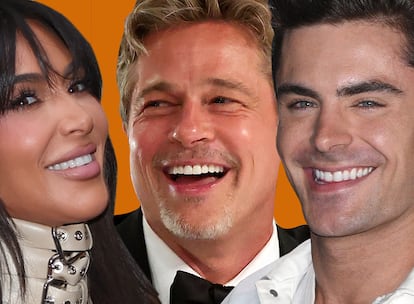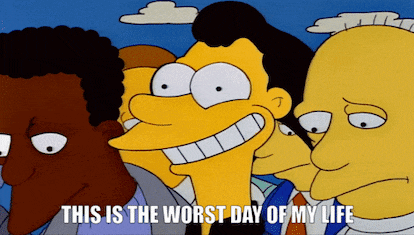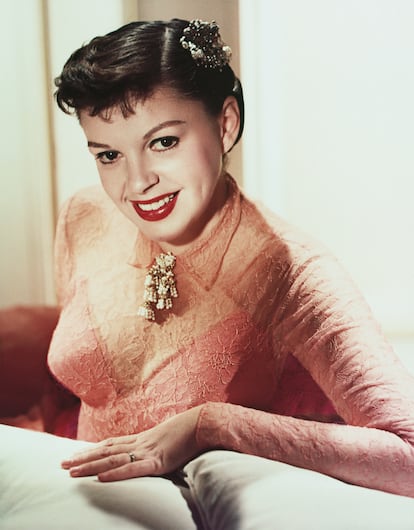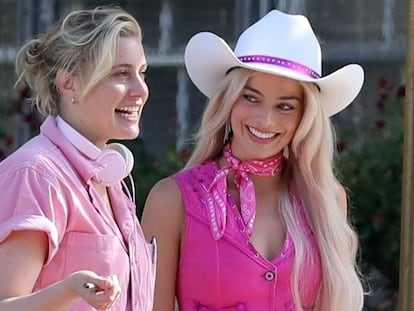‘The white we demand in our teeth does not exist in nature’: How Hollywood established impossible dental perfection
The desire for ever whiter teeth popularized celebrities could finally be meeting its end

“Unpopular opinion: very white teeth are rare,” writes a user on Reddit. In addition, if all the people in a closed space have perfectly aligned teeth and exactly the same range of white smiles, it is creepy. It is almost dystopian. Another opinion, was expressed by Bad Bunny: “No matter how ugly your teeth are, don’t have them fixed. I regret it every day of my life.” The artist complained that it seems like “you’re still not an artist until you get your teeth done.” He said this four years ago, but it seems that the message did not sink in.
A dentist with a practice in Beverly Hills told Allure magazine that while watching the last Golden Globes ceremony he counted how many attendees had kept their natural teeth. According to his calculation, only 20% had the teeth they had won in the genetic lottery. It seemed to the Allure journalist that the dentist had miscounted. Given the glitziness of the event, she expected 99% synthetic smiles.
“His smile lit up the entire room.” The corniest metaphor of all time is about to become literal. Between applause and wide, radiant smiles, the work of Hollywood’s finest dentists dazzles at any gala, show business event, or awards ceremony. White teeth are a staple in Hollywood, and, by extension, among celebrities and personalities in all the arts. Any actor knows that after signing their contract at the producer’s office in Los Angeles, they will go directly to the dentist’s office who will adjust the incisors and canines to the current aesthetic standards: straight, square, perfectly aligned, and very white. Mouths all over the world are beginning to look the same.
Elevating your smile to a Hollywood shine is just a routine stop on the way to a manufactured aesthetic that includes changing your hair color, reshaping your silhouette (with diet, exercise, and a few shots of Ozempic), injecting a few doses of Botox to rejuvenate your face, and filling lips with a few vials of hyaluronic acid for a less gummy smile. Your new appearance is bound to please and kill any personality trait that distorts the aesthetic standard. You will have already seen in any movie or television series that the smiles are wide, white, and perfectly aligned, regardless of the socioeconomic status of the actor or the era in which the story takes place.
“What they ask of us in the consultation [increasingly whiter teeth] is the result of what people perceive as aspirational on television, in series, or in football games,” says María Rosa Fernández, an orthodontic dentist and professor of the master’s degree in Orthodontics at the Alfonso X University, in Spain.
An aspiration that Charles Beaumont captured in his science fiction tale The Beautiful People in 1952. In it the characters submitted themselves to various aesthetic transformations, and their most recurrent hope was for: “White, white teeth, even, sparkling.” In a famous episode of The Simpsons, Lenny put on a perfect smile thinking it would help him get rich and, now poor, he is unable to stop smiling even when he gets fired. “This is the worst day of my life,” he says while smiling. The image, 30 years later, is a common meme on social media.

Perhaps that’s why Spanish rapper C. Tangana’s crooked, naturally-toned teeth are occasionally a topic of conversation. It is the most transgressive thing we have seen in recent times. It is an aesthetic and social challenge, and a relief. The same can be said about Madonna’s or Channing Tatum’s teeth. “I see a vindication there,” says Elena Carrión, also an orthodontist and professor of the Master’s in Orthodontics at the Alfonso X University. Carrión and Fernández have a name for the dazzling shade of fashionable teeth: “We call it ‘Roca white’ [the color of the porcelain toilets the company produces].”
“It is a color that does not exist in nature. We work with the Vita whitening guide, a color guide inspired by the natural tones of teeth that tend to tend towards gray or yellow, and Roca white does not appear in it,” explains Carrión. “But people think their teeth are never white enough. A lot of the time they come to the consultation asking for teeth whitening but when they show you what they want, you see that they are not natural teeth but veneers,” María Rosa Fernández replies.
The issue of teeth whitening is so much in the public domain that the Daily Mail dedicated an article to the new teeth that Brad Pitt showed off at the 2023 Golden Globes. Three years earlier, he had visited Kim Kardashian’s dentist with the aim of maintaining large, uniform teeth with a striking bluish white tone (or “pearly,” in the words of the British tabloid).
The Pantone color of Hollywood celebrities’ teeth was established by the so-called Marashi Collection, a collection of six ‘premium’ porcelain shades with names like Sassy Smile or Undeniably White.
The dental veneer is a small sheet that can be made of porcelain or composite material and adheres to the front of the tooth to improve its shape, color, and shine. It is also able to mask stains and other problems. It is usually a quick and highly sought after beauty solution. Covers or crowns are also used that cover the entire piece and are a little more invasive, with the healthy (or otherwise) teeth being hidden under them.
“Most Hollywood actors have veneers or crowns,” says Mariano Abruzzesi, a cosmetic dentist at SHA Wellness Clinic, adding: “With veneers you can achieve a natural appearance as long as you don’t aim for the nuclear white target.” Abruzzesi takes out his color guide and mentions that not even the shade of the whitest veneer is the same as the Hollywood smile. “The general tendency is for the patient to want increasingly whiter teeth. I always try to remove a shade from what they have chosen, and I have never managed to deliver the most extreme white because it does not seem natural to me.”
Attempts to bleach a natural tooth also have limits. “There comes a time when the tooth becomes saturated, and it no longer whitens,” says the dentist. Elena Carrión warns that we are facing a case of misleading advertising. “It is a treatment that should be called dental lightening, not whitening, because the tooth will lighten but always from its natural tone, which tends to lean towards gray or yellow rather than white.”

Humans’ obsession with white teeth is at least 5,000 years old. It is believed that in Ancient Egypt pumice stone and vinegar were mixed to make a toothpaste with a whitening effect. From then on, snowy white teeth have been a symbol of beauty, wealth, and power. In Hollywood, the craze for white teeth was recorded at some point in the interwar period.
A dentist named Charles Pincus “fixed” Judy Garland’s smile, which must have had many spaces between her teeth, with some covers that were probably the first dental veneers in Hollywood. Then, with the same technique, he solved the damage that James Dean did to his incisors after falling from a trapeze. Among his other clients were Shirley Temple, Joan Crawford, Bob Hope, and Walt Disney.
Having a perfect white smile became an achievable but uncomfortable requirement to work in the cinema. Pincus’ veneers were a mixture of plastic and porcelain powder that were fitted onto the actors’ teeth and could remain in place for an indeterminate amount of time, ranging from a few hours to several days. It was not until 1983 that a New York dentist, John Calamia, devised permanent veneers that fitted precisely and lasted for several years. All of this assumes that porcelain dental veneers have been around for no more than four decades.
Nowadays, the unrealistic whiteness of famous people’s teeth, and those of more and more ordinary people, has a lot to do with the filter on display screens: the big ones, plasma and HD, and the small ones like smartphones, which have imposed a demand for aesthetic perfection that has been separated once and for all from nature.
The Pantone color of Hollywood celebrities’ teeth was established by the so-called Marashi Collection. The collection of six premium porcelain shades includes names like Sassy Smile (for former heavy smokers) or Undeniably White (for those who want to light up a room with their synthetic smile). The collection was created by Jon Marashi, a cosmetic dentist from Los Angeles who is credited with the new perfect smile of Ben Affleck, who in his youth sported apparently healthy, but small and somewhat uneven teeth. Marashi is said to have destroyed Joaquin Phoenix’s teeth in 2019 for the Joker character and then fixed them again for the film’s promotional tour.
If this happened it would be a true exception to the rule: white teeth are ubiquitous and beyond any script requirement. We see that in Game of Thrones (HBO) the action takes place in a kind of Medieval period: there is plague, there are wars, but everyone, from kings to concubines, has impeccable teeth. Something similar happened in Euphoria, where there was no trace of the bite problems and dental crowding that are common in adolescents, especially if their diet is based on beer and opioids.
White teeth, more than an aesthetic, are an ideology. A test of the will and economic ability of an individual to optimize their physical qualities with technological interventions that are more or less long and more or less painful and invasive, but effective, and with a predictable aesthetic result that can be cloned ad infinitum. It doesn’t matter that in a dark room all the teeth are white, sparkling, and identical. That seems, in fact, to be the goal. Nobody wants surprises, and teeth that have not been tamed by the orthodontist or that have not been whitened are an act of rebellion that, in some environments, can be interpreted as a sign of neglect or, what is worse, poverty.
For now, if you are successful like C. Tangana, and you smile and show undisciplined teeth, you have a lot of charisma. But perhaps there are still people who do not like dystopian white teeth and, in the absence of a medical imperative, prefer their own. Sometimes the shortest path is not the worst.
Sign up for our weekly newsletter to get more English-language news coverage from EL PAÍS USA Edition
Tu suscripción se está usando en otro dispositivo
¿Quieres añadir otro usuario a tu suscripción?
Si continúas leyendo en este dispositivo, no se podrá leer en el otro.
FlechaTu suscripción se está usando en otro dispositivo y solo puedes acceder a EL PAÍS desde un dispositivo a la vez.
Si quieres compartir tu cuenta, cambia tu suscripción a la modalidad Premium, así podrás añadir otro usuario. Cada uno accederá con su propia cuenta de email, lo que os permitirá personalizar vuestra experiencia en EL PAÍS.
¿Tienes una suscripción de empresa? Accede aquí para contratar más cuentas.
En el caso de no saber quién está usando tu cuenta, te recomendamos cambiar tu contraseña aquí.
Si decides continuar compartiendo tu cuenta, este mensaje se mostrará en tu dispositivo y en el de la otra persona que está usando tu cuenta de forma indefinida, afectando a tu experiencia de lectura. Puedes consultar aquí los términos y condiciones de la suscripción digital.
More information
Archived In
Últimas noticias
Welcome to the post-religion era: The idea of Christianity as the absolute truth has become obsolete
‘I thought you would like it’: The risky sexual practice popularized by TV shows and TikTok
The digitalization of tourism: ‘They promise experiences and gave us the worst possible one’
Mexican peso defies uncertainty with forecasts of a new period of stability in 2026
Most viewed
- Sinaloa Cartel war is taking its toll on Los Chapitos
- Reinhard Genzel, Nobel laureate in physics: ‘One-minute videos will never give you the truth’
- Oona Chaplin: ‘I told James Cameron that I was living in a treehouse and starting a permaculture project with a friend’
- Why the price of coffee has skyrocketed: from Brazilian plantations to specialty coffee houses
- Silver prices are going crazy: This is what’s fueling the rally











































